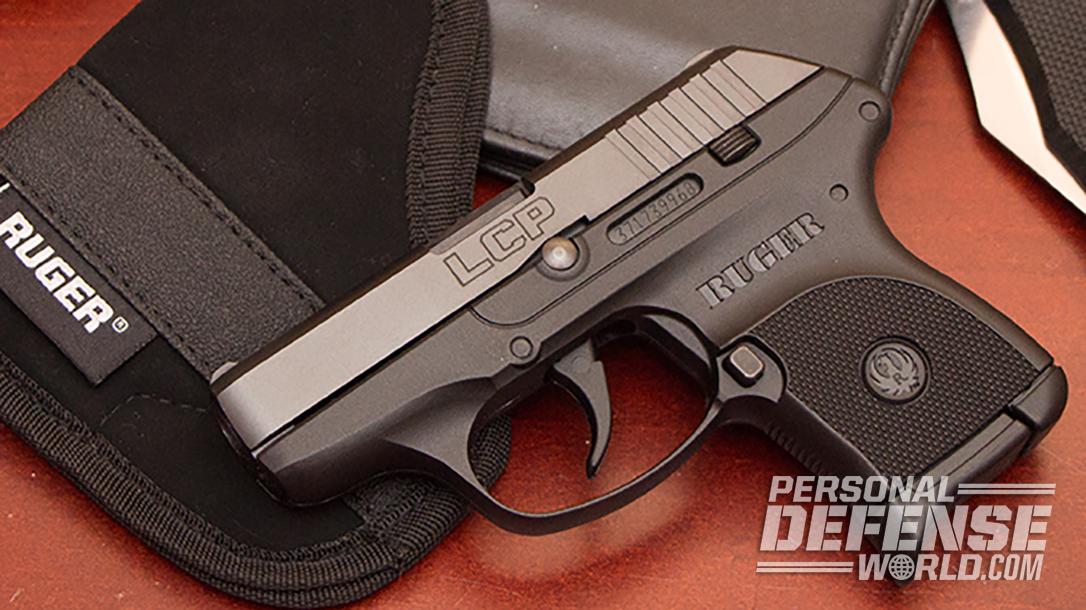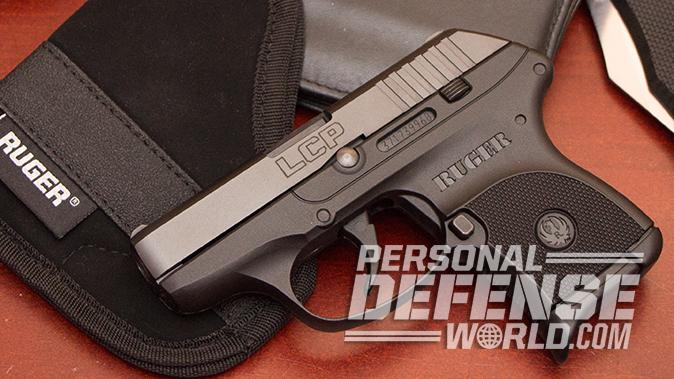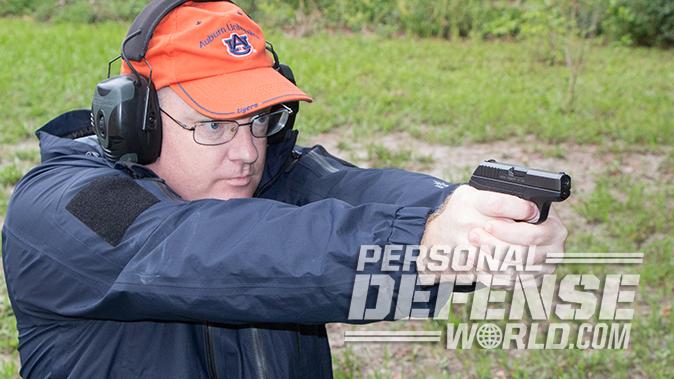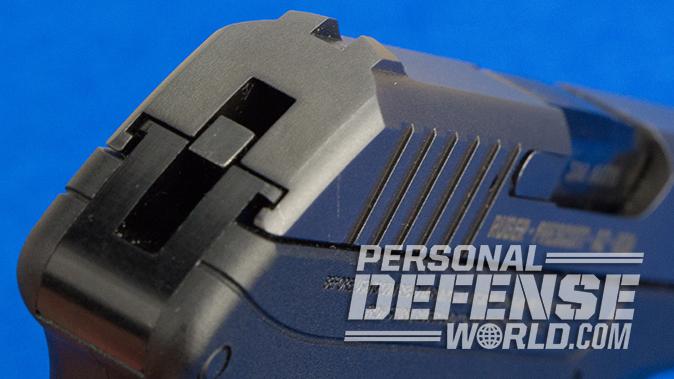Thomas Jefferson once said, “There is not a sprig of grass that shoots uninteresting to me.” His idea was that everything in creation, no matter how small, had a role to play and was worthy of study. Perhaps following Jefferson’s example, Sturm, Ruger & Company understands that guns of all sizes have a role to play in self-defense. While large guns may offer more capacity and larger calibers, very small guns can have a major impact on the lives of those who carry them.
Enter The LCP
I remember being at the SHOT Show in 2008 when the Ruger LCP was introduced. There were small .380 ACP pistols offered by other companies, but the Ruger model seemed to stand on its own due to its combination of features, size and price. Quite a few gun writers and dealers were talking about the gun then, and now, nearly a decade later, many people are still enamored with the gun. Why?
Advertisement — Continue Reading Below
Fundamentally, the gun lives up to its name. LCP stands for “Lightweight Compact Pistol”—and that’s exactly what it is. It’s about 0.8 inches thick and weighs less than 10 ounces unloaded. Roughly 5 inches long overall, this gun disappears into a pocket or waistband, giving the owner a nearly perfect way to discreetly carry a self-defense firearm.
While the .380 ACP won’t earn top marks for that elusive thing called “stopping power,” it is still a respectable cartridge and an impressive step up from the smaller rounds available on the market. Seven rounds of this classic cartridge would certainly seem to be enough for most personal-protection scenarios. Considering I’ve carried a five-shot J-Frame in a front pocket for much of my adult life, having two additional cartridges without any additional bulk seems like a luxury.
Ruger has always been respected for building dependable firearms. With nearly indestructible handguns like the GP100 in its catalog, the LCP benefits from a halo effect by simply having the company name on the frame. When you mix in the incredibly low suggested retail price of only $259, the question changes from “why” to “why not?”
Advertisement — Continue Reading Below
Pocket Carry
If, in fact, every gun has a role to play, it is clear that the Ruger LCP was born to star as a pocket pistol. Its flat surface minimizes printing while riding in your pants, and its short overall length keeps the butt from peeking out of the top of your pocket. This gun can take a supporting role in an appendix holster, but it is clearly meant for carry inside the pocket, not the waistband.
Should you have any doubt about Ruger’s design intentions, the company includes a pocket holster with the gun. The synthetic holster has a suede-like exterior with a strip of rubber-like material around its midriff. Presumably, the holster’s exterior will help keep the gun from flopping about in a large pocket while anchoring the holster when the gun is drawn from the pants.
Even though the included scabbard did a good job of breaking up the outline of the pistol, I found that it would not consistently part company with the Ruger LCP when I drew the gun. This can lead to the far-less-optimal scenario of sometimes pointing a holster at the target rather than the gun alone.
Advertisement — Continue Reading Below
Other Options
Manufacturers differ on holster designs, but generally the use of a tacky material combined with the use of a wide “wing” to catch on the inside of the pocket is the most reliable method of separating the gun from the scabbard. The rubber strip did not seem to provide any significant friction in my pocket while the wing under the grip isn’t very wide. Instead of curving up to form a hook to catch the pocket corner, it slopes down to make it more likely to simply slip right out of the pocket with the gun. Some break-in time might put this issue to bed, or you can go to Plan B.
Fortunately, there are many other options for pocket rigs on the market. Two of my favorites are the synthetic DeSantis Nemesis and the leather Flat Pocket Holster from RKBA Holsters. Both of these holsters are affordable and have proven themselves in years of use with my guns.
Range Testing
Let’s be perfectly honest: A pocket gun is not an ideal combat handgun. To be small enough to slip into a trouser pocket, certain compromises must be made. For the most part, we are talking about size—the size of the grip, sights magazine and even cartridge all comes into play. Shrink things too much and you wind up with a gun that is too small to be effectively employed or, even worse, one that is unreliable.
Advertisement — Continue Reading Below
The only way to tell if Ruger got it right was to head out to the range with a pack full of ammo. So that’s what I did. I tested the Ruger LCP with 400 rounds of ammunition from the folks at Aguila, Hornady, Liberty Ammunition and Winchester. I believe this is enough rounds to get a feel for the gun and determine if it will be reliable.
One of the concerns I had was the lack of real estate for my hand. With the extended floorplate on the magazine, I barely got two fingers from my medium-sized hand on the gun. Even with a mild cartridge like the .380 ACP, not having a good grip on the pistol can lead to excessive muzzle flip. But I discovered that recoil wasn’t as big a problem as I thought. While a larger grip would definitely make this a complete pussycat to shoot, it would also ruin the gun’s extreme concealability. The recoil was very manageable with all of the loads I tested.
Liberty & Winchester
Liberty Ammunition’s 50-grain JHP load is a speed demon. The company uses a nickel-jacketed, all-copper-core hollow point that is light for the caliber, especially when you consider that most .380 ACP rounds carry 90- or 95-grain projectiles. But the Liberty round’s lighter weight allows the bullet to reach a much higher velocity for greater expansion. In my testing, the Liberty rounds averaged more than 1,300 fps out of the LCP’s 2.75-inch barrel. For a .380, especially a small one, that is an unheard of velocity. Reliability with this round was also perfect, and I didn’t notice any additional recoil, though these rounds tended to hit slightly higher on the target than the others —between half an inch and an inch at 7 yards.
Advertisement — Continue Reading Below
Winchester’s PDX1 turned in the best groups of the day. Completely un-supported, I managed a best five-shot group of 0.99 inches at 7 yards. Not bad at all considering the size of the gun and the age of my eyes. Truthfully, I was not terribly surprised that this load produced the tightest group, as I have found the PDX1 to show excellent accuracy in a number of handguns I have tested.
I mentioned the age of my eyes because the sights on the Ruger LCP are biased toward concealment. In other words, they are pretty darn small. The good news is that they will not catch on your pocket when drawing. However, the downside is they are harder to use—especially under stress and in low-light conditions. For shooting on the range, they are adequate and even better than some of the options from competitive pistols.
Additional Factors
If having better sights is important to you, take a look at Ruger’s LCP Custom. For only $10 more than the standard LCP, you get much larger sights, including a photoluminescent front. For many people, that could be the best $10 investment you will ever make in a pistol.
Advertisement — Continue Reading Below
The only malfunction I experienced was with the Aguila load. This round is a 95-grain FMJ, or ball, load. I was a bit surprised to see a problem with it, and I cannot be sure of what exactly caused the problem. With about 50 rounds through the gun, the third round in the magazine failed to feed. The spent shell ejected properly, but the nose of the next round appeared to hang on the ramp. Pulling the slide to the rear sharply allowed the cartridge to chamber, and I returned to firing. I experienced no additional problems with the Aguila or the LCP for the rest of the day.
Some companies making small pistols delete the slide stop. This prevents you from locking the slide to the rear for cleaning and inspection. Ruger smartly designed a manual slide hold-open lever into the left side of the gun. While the slide will not lock back when the magazine runs dry, you can manually engage the lever to keep the slide open. To keep things flat, the hold-open lever is relatively small and barely protrudes beyond the frame. For those with arthritis or dexterity issues, it may be somewhat difficult to engage this lever.
Advertisement — Continue Reading Below
Discreet Performer
Overall, I think the Ruger LCP is an outstanding performer for the role it plays. The LCP is not a bedside gun for fighting off a home invasion. Rather, this little gun tucks neatly into tailored pants when discretion is a must. In this context, it delivers good accuracy with a respectable cartridge and capacity. Wrap in the Ruger name and ridiculously inexpensive price, and I only have one question: Why don’t you already own one?
Ruger LCP Specs
- Caliber: .380 ACP
- Barrel: 2.75 inches
- OA Length: 5.16 inches
- Weight: 9.6 ounces (empty)
- Grip: Glass-filled nylon
- Sights: Fixed
- Action: DAO
- Finish: Matte black
- Capacity: 6+1
- MSRP: $259
Ruger LCP Performance
| Load | Velocity | Accuracy |
|---|---|---|
| Hornady 90 Critical Defense FTX | 891 | 1.46 |
| Liberty 50 JHP | 1,310 | 1.52 |
| Winchester PDX1 Defender JHP | 902 | 0.99 |
*Bullet weight measured in grains, velocity measured in fps by chronograph and accuracy measured in inches for best five-shot groups at 7 yards.
For more information, visit ruger.com.
Advertisement — Continue Reading Below
This M&P340 review was originally published in “Pocket Pistols” #186. To subscribe, visit outdoorgroupstore.com.

































